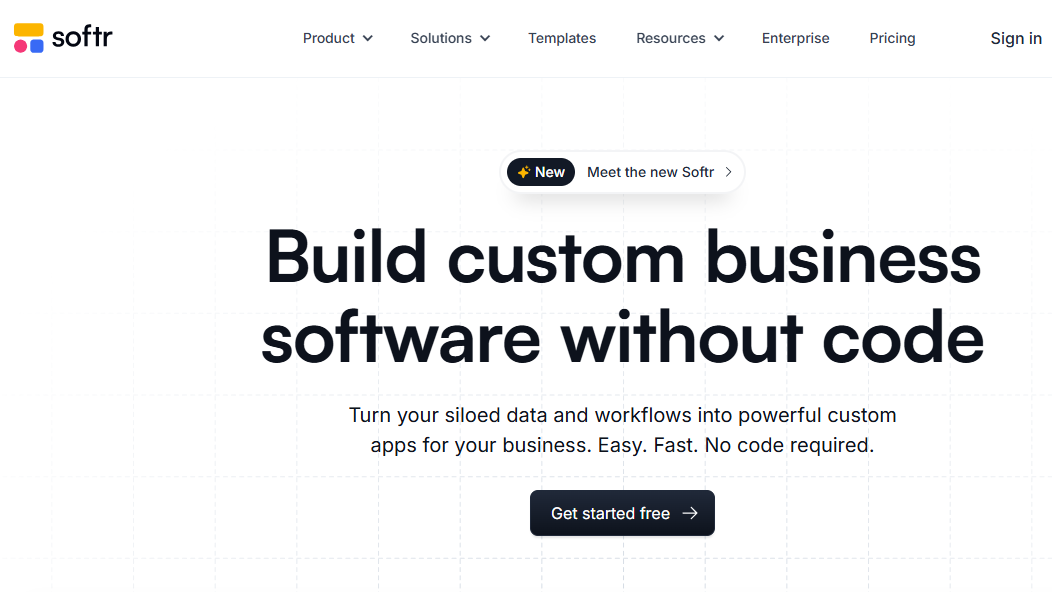Why you can trust TechRadar
We spend hours testing every product or service we review, so you can be sure you’re buying the best. Find out more about how we test.
Softr is a no-code platform that can help you create all kinds of web apps, marketplaces, ERP, dashboards, and more, all from a visual editor, without writing a single line of code. Together with its peers, Softr has gained traction in recent years thanks to its promise of democratizing and streamlining the app creation process.
In this review, we’ll explore Softr’s standout features, user interface, ease of use, integration and extensibility, deployment and maintenance, pricing, and documentation, and compare it with some of its peers in the no-code space.
Softr: Features
Softr gives you access to over 90 pre-built templates that you can use as starting points to launch web apps faster than starting with a clean slate. You’ll find templates to create help desk portals, all kinds of internal business tools, CRMs, member communities, marketplaces, and a lot more.
Each template has its own layout, and customizable options, which you can tweak as per your needs.
Keeping up with the times, the platform also offers you the option to create an app with an AI prompt.
Irrespective of how you start your app, the platform will ease its customization thanks to its drag-and-drop interface. The interface makes it rather straightforward to create layouts, structure pages, and tweak components inside them. The simplicity of it all ensures that even if you don’t have any prior web development experience, you can cobble together a web app without too much fuss.
Softr also supports user management and authentication features, to help create gated content, subscription-based services, or private communities. You can enable email-based logins, two-factor authentication, Google sign-in, and even SSO via SAML and OpenID protocols. You can also create different user groups and control what each group can see, or do.
Similarly, Softr offers integrated payment processing through Stripe, to help build subscription-based apps. It also supports PayPal, and Gumroad for digital purchases.
While it originally started as an interface on top of Airtable, Softr can now work with popular third-party databases, ranging from simple options like Google Sheets, and Notion to relational databases like PostgreSQL, MySQL, MariaDB, and more.
You can also create workflows, and automate tasks by integrating your Softr-built app with the Zapier automation platform. This will help set up triggers and actions between your app and other services, for instance to send personalized welcome emails, or for adding users to a CRM, and such.
Best of all, Softr ensures that all your apps are responsive, and display nicely on desktops, tablets, and smartphones.
Softr: Interface and Ease of Use
The platform’s interface is clean and user-friendly. The dashboard gives you access to your projects, as well as the ability to create new ones. You can either start with a blank canvas, use a template, or generate an app with AI.
Softr’s design interface is straightforward, with a navigation bar on the left side where you can access key components like Pages, Themes, Database, Users, and Settings.
You can easily create pages, tweak layout by repositioning or adding, and deleting blocks, all without dealing with complex menus or settings.
All pages have blocks, which you can think of as pre-designed components that cater to different purposes. For instance, you can add a Calendar block to map project deadlines, or coordinate team schedules, and such.
You can customize any block from a properties panel that appears when a block is selected. While it does quicken the app creation process, remember though that Softr blocks don’t give you the same level of design freedom that you get with other platforms like Bubble.
For instance, you can add multiple CTA buttons to your app, and change their order of appearance, but can’t reposition them to any part of the page, as you can with Bubble.
As you are building, you can use Softr’s Preview function to look at your app. Very helpfully, it gives you the option to look at the app from the point of view of any user, including logged out users.
You can use the device selector to preview the app as it would appear on devices with different screen sizes. Interestingly, you can even scan the QR code to preview the app on your actual device as well, without installing additional apps.
Softr: Integration and Extensibility
The Airtable integration is one of Softr’s biggest strengths, enabling users to easily manage data and display it within their applications.
Beyond Airtable, Softr connects natively to simple spreadsheets, SQL databases, and even data warehouses like BigQuery.
On top of that it also integrates with business apps like HubSpot Chat, Documint, Google Analytics, and more. The platform also natively supports Stripe, PayPal, and Gumroad to help you roll in e-commerce functionality in your apps.
If you want more, you can connect your apps to more sources with Softr’s recently introduced REST API connector.
Similarly, you can break beyond Softr’s default capabilities by embedding JavaScript into your app’s pages. Thanks to this flexibility, you can inject your own code snippets, and there are lots of commonly used code snippets in the documentation, and even embed third-party widgets directly into their applications. You can, for instance, easily embed Calendly in your Softr app to schedule and manage appointments.
Softr: Deployment and Maintenance
Once you’ve developed and previewed your app, you can easily deploy them to a live domain, literally with a single click.
The platform relies on the AWS infrastructure, and like its peers, it too handles hosting, domain management, and SSL certificates.
When deploying an app, the platform gives you the option to deploy it to a free Softr subdomain. Or, if your membership tier allows it, you can also point Softr to a custom domain, and publish there instead.
The platform claims it’ll automatically scale all Softr apps according to traffic, which makes the platform suitable for all kinds of businesses, and use cases. However, while not many users have faced any performance issues with their apps, some advise caution for using the platform to build large-scale apps, primarily depending on where you have stored your data.
Softr: Pricing and Documentation
Softr offers a tiered pricing structure.
The free plan includes a basic set of features. You can use it to explore the platform, and build small, personal apps, or prototypes. While you can only publish one app, you can invite as many collaborators as you want to help build the app. It also limits the number of building blocks, the data sources, and the number of records you can use in your app.
Paid plans unlock more advanced features such as custom domains, more data sources, and integrations, and the ability to remove Softr branding. The Basic plan starts at $59/month (or $49/month billed annually) and lets you publish three apps.
Then there’s the $167/month Professional plan ($139/month billed annually), and the $323/month Business plan ($269/month billed annually). As you move up the tier, you’ll get additional features, and functionality, as well as more support options.
Talking of support, Softr offers comprehensive text, and video documentation, howtos, and courses, for new users. The documentation covers everything from getting started to publishing. It also has detailed, illustrated guides on advanced topics such as integrating third-party tools, and writing custom code.
In addition to the documentation, Softr offers support through a community forum, and a 24/7 live chat. Some paid tiers also get a personalized onboarding call, and priority support.
Softr: The Competition
Softr shares the space with several other point-and-click no-code platforms that can all churn out web apps.
For starters there’s Bubble, which is often thought of as a more robust platform than Softr, especially when it comes to building complex apps. Bubble offers greater flexibility, though it comes with a steeper learning curve.
Then there’s Bildr, which puts great emphasis on visual development, and offers far more customization freedom. Bildr’s best for those of you who want better control over both the backend and frontend of your web apps. But this means that just like Bubble, Bildr too has a steeper learning curve than Softr.
On the other hand, Softr is a better option for you if you want simplicity, and quick deployment. You also get that same level of simplicity with Adalo, though this platform is primarily designed to build mobile apps.
Softr: Final Verdict
Softr is a good no-code platform for anyone who wants to use their existing business data to build, and roll out web apps quickly. Its plethora of templates, AI builder, and drag-and-drop interface, make it an attractive option for non-technical users.
That said, while Softr is an excellent platform for those who need to deploy quickly, it might fall short for users who need deep customization, and control over their apps.
All things considered, while Softr isn’t as extensible as some of its peers, its ease of use makes it a wonderful platform for creating all kinds of business apps, dashboards, and marketplaces.
But this might soon change for the better, as Softr is set to inherit full-stack app-building capabilities. When these updates roll out, sometime in 2025, you’ll no longer need third-party workflow automation tools, and external databases, which will open up the platform to an even wider range of use cases.
Check out our list of Best Enterprise Resource Planning (ERP) software.
Read the full article here














